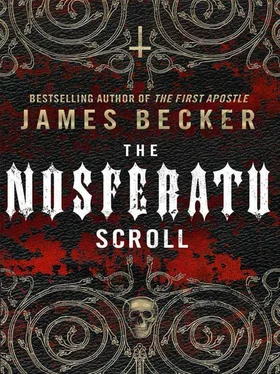James Becker - The Nosferatu Scroll
Здесь есть возможность читать онлайн «James Becker - The Nosferatu Scroll» весь текст электронной книги совершенно бесплатно (целиком полную версию без сокращений). В некоторых случаях можно слушать аудио, скачать через торрент в формате fb2 и присутствует краткое содержание. Жанр: Триллер, на английском языке. Описание произведения, (предисловие) а так же отзывы посетителей доступны на портале библиотеки ЛибКат.
- Название:The Nosferatu Scroll
- Автор:
- Жанр:
- Год:неизвестен
- ISBN:нет данных
- Рейтинг книги:4 / 5. Голосов: 1
-
Избранное:Добавить в избранное
- Отзывы:
-
Ваша оценка:
- 80
- 1
- 2
- 3
- 4
- 5
The Nosferatu Scroll: краткое содержание, описание и аннотация
Предлагаем к чтению аннотацию, описание, краткое содержание или предисловие (зависит от того, что написал сам автор книги «The Nosferatu Scroll»). Если вы не нашли необходимую информацию о книге — напишите в комментариях, мы постараемся отыскать её.
The Nosferatu Scroll — читать онлайн бесплатно полную книгу (весь текст) целиком
Ниже представлен текст книги, разбитый по страницам. Система сохранения места последней прочитанной страницы, позволяет с удобством читать онлайн бесплатно книгу «The Nosferatu Scroll», без необходимости каждый раз заново искать на чём Вы остановились. Поставьте закладку, и сможете в любой момент перейти на страницу, на которой закончили чтение.
Интервал:
Закладка:
12
A stocky, middle-aged man, his black hair showing the first subtle shadings of grey at the temples, walked out of the elegant building situated a short distance from the Piazza San Marco and turned north, heading for the Campo Santa Maria Formosa. It was a sensible place for a meeting, away from the more usual haunts of the tourists who still thronged the city, and with several cafes and bars were two men could sit together quietly and exchange confidences. In fact, Carlo Lombardi had not the slightest intention of saying very much at all: he was going to the square to receive information; important information, he hoped.
The call he’d taken in his office about a quarter of an hour earlier had been the first important break they’d received in the case — assuming, of course, that the man who had telephoned the police station really did know something of value about the multiple killings of young women that were currently plaguing the city.
Lombardi shook his head as he strode down the street, casting off his doubts. The caller was clearly well informed, because he had already mentioned one fact about the series of murders that had never been released to the press, or publicized in any way at all. Whoever he was — he’d told Lombardi to call him ‘Marco’, a common enough Italian name and almost certainly not his true identity — he had at least one piece of information that was known only to the perpetrators and the police. If he hadn’t been involved in the killings himself, then it was at least probable that he had been a witness to them.
In any event, he was somebody that Lombardi, as the senior investigating officer in charge of the case, needed to talk to. ‘Marco’ had told Lombardi that he would only meet him alone and face-to-face in a public area, and the Campo Santa Maria Formosa had seemed as good a spot as any. And Lombardi was going there alone and on foot, as he’d been instructed, just in case the man was mounting surveillance of the streets between the police station and the square. But that didn’t mean that their meeting would go unobserved.
Lombardi had already dispatched a dozen police officers to cover the eight or so exits from the Campo, and four more to position themselves with parabolic microphones and high-resolution still and video cameras in a couple of the buildings that lined the square, to record the meeting. ‘Marco’ would find it easy enough to get to the Campo and to the cafe he’d selected, but he would find it much more difficult to leave afterwards.
Lombardi’s orders had been absolutely clear: the man he was going to meet was to be arrested as soon as he left the cafe.
The senior police officer didn’t hurry as he walked up the Calle Drio La Chiesa, allowing his men plenty of time to get into position. He turned left past the Museo Guidi, still closed after proving too expensive to run, then right again, following the west bank of the canal towards the square.
Carlo Lombardi had been born in Venice and prided himself on knowing every street and alley and canal in the city, and he believed he’d covered every possible way out. He was quite certain that once ‘Marco’ walked into the Campo Santa Maria Formosa, he would only leave the square in handcuffs. And, at last, they might finally have a break in the case that had been both puzzling and alarming Venetian police officers for the previous two years.
He still remembered that dreadful afternoon when he’d responded to a call from one of his senior inspectors, and had travelled in a police launch out to the Isola di San Michele. He had stood over a shallow pit behind a line of trees and looked down on to the white and waxy naked body of a twenty-year-old girl, apparently dumped there only a few hours earlier. Her eyes had been wide open, though already discoloured by the action of insects, attracted by the faint smell of decomposition. As Lombardi had stared down at the body, he’d heard a faint buzzing sound, and then a couple of blowflies had emerged from the girl’s open mouth, where they’d doubtless been laying eggs. Other flies were clustered around the left-hand side of her neck.
Lombardi had looked at the inspector, his eyes questioning, but the man had simply flapped a handkerchief beside the girl’s neck to drive away the insects. And then he and Lombardi had stared down at the fatal wound, its edges raised and ragged, which marred the perfect white skin of the corpse.
The results of the subsequent autopsy hadn’t been a surprise. The girl had died from loss of blood — exsanguination — which had pumped out of the wound on her neck. There was also clear evidence of restraints: the marks of ropes or straps around her wrists and ankles. And she’d been raped, raped violently, several times, her genital area marred by heavy bruising. The body had yielded no useful clues to suggest where the girl had died, or any indication of the identity of her killers. Despite the evidence of rape, traces of lubrication within her vagina meant that the rapist, or rapists, had used a condom; and the body appeared to have been thoroughly washed after death to remove any pubic hairs or other trace evidence.
The one slight oddity revealed at the post-mortem was the contents of the stomach. Very shortly before she died, the girl had ingested about a quarter of a litre of milk. That in itself was unsurprising, but extensive bruising to the lips and the inside of her mouth suggested she might have been force-fed the liquid, which was unusual. But the analysis of the milk itself provided the biggest surprise, because the pathologist hadn’t been able to identify the animal from which it came. All he could tell Lombardi was that it wasn’t from a cow, sheep, goat or any other farmed animal he was aware of, nor even from a human female. It simply wasn’t in the database.
There were, of course, a lot of animal species in which the female produced milk to nourish her offspring, and testing the samples removed from the dead girl’s stomach against every possible mammal would have been a lengthy and very expensive process — and probably ultimately pointless. So Lombardi had told the pathologist not to bother, because it was already clear that the milk hadn’t contained any form of drug, and had in no way contributed to the girl’s death. It was just a curious anomaly.
Lombardi was quickly convinced that she had been the victim of a kind of ritualized murder, and he’d vowed there and then that he would bring the perpetrators — and there were obvious indicators that several men had been involved — to justice.
Since then, there had been other disappearances of young girls, usually between the ages of eighteen and twenty-five. Some of the bodies had been found, but in other cases the girls had simply vanished without trace. The recovered corpses bore the same indicators of a hideous death as the first corpse: evidence of multiple rape and exsanguination through severe wounds in the neck. And in every case, a small amount of the unidentifiable milk had been recovered from the victim’s stomach.
Lombardi mused on this as he walked along beside the canal. As was so often the case with investigations into serious crimes, the Italian police had been plagued by the usual crop of nutters who wanted to confess to the murders, or to produce convincing — to them — evidence that the killer was the man next door or the Pope or the American President or even a visiting alien. They’d talked to most of them, just in case they were involved in some way, but they were quite satisfied that none of the people they’d interviewed had had anything to do with the crimes.
But the thing that had convinced Lombardi that ‘Marco’ could help him with the murders was the single sentence the man had said during his telephone conversation: ‘I know about the milk.’
Читать дальшеИнтервал:
Закладка:
Похожие книги на «The Nosferatu Scroll»
Представляем Вашему вниманию похожие книги на «The Nosferatu Scroll» списком для выбора. Мы отобрали схожую по названию и смыслу литературу в надежде предоставить читателям больше вариантов отыскать новые, интересные, ещё непрочитанные произведения.
Обсуждение, отзывы о книге «The Nosferatu Scroll» и просто собственные мнения читателей. Оставьте ваши комментарии, напишите, что Вы думаете о произведении, его смысле или главных героях. Укажите что конкретно понравилось, а что нет, и почему Вы так считаете.












